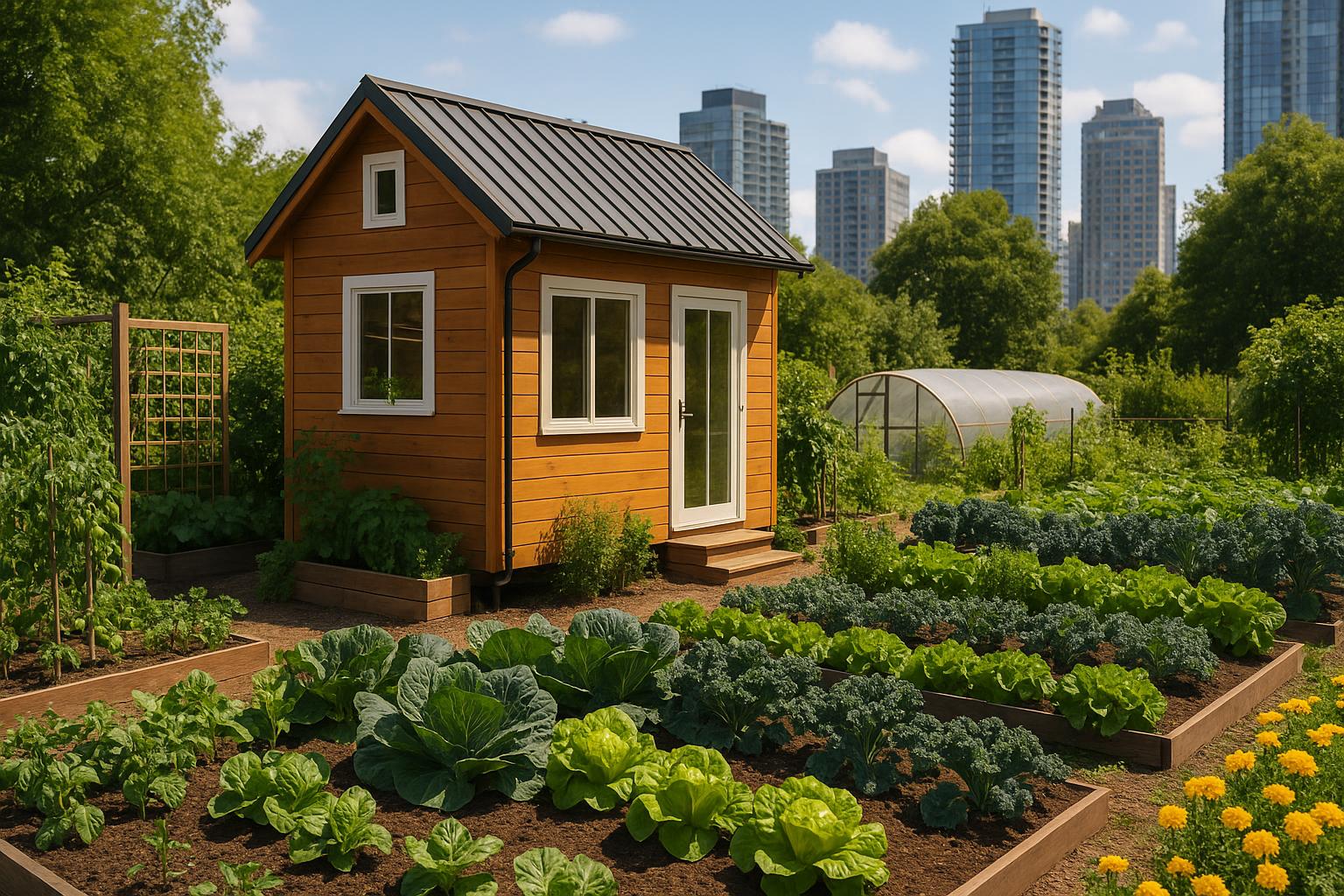
Tiny Homes Urban Agriculture: Canada’s Sustainable Living Trend for 2025
Estimated reading time: 8 minutes
Key Takeaways
- Affordability and Sustainability: Tiny homes offer an affordable housing solution while urban agriculture enhances local food security.
- Community and Environmental Impact: Combining compact living with shared gardens fosters community engagement and reduces environmental footprints.
- Innovative Technologies: Advances such as AI-enabled gardening and smart irrigation systems are revolutionizing urban farming methods.
- Supportive Policies: Progressive zoning reforms and municipal grants in cities like Edmonton and Okotoks are paving the way for growth.
Table of contents
- Introduction: Tiny Homes Urban Agriculture in Canada and the Rise of 2025 Trends
- Overview of Urban Agriculture in Canada
- Tiny Homes in Canada: A Foundation for Sustainable Living
- Integrating Tiny Homes with Urban Agriculture in Canada
- Benefits of Tiny Homes Urban Agriculture for Canadians
- 2025 Trends: The Future of Tiny Homes Urban Agriculture in Canada
- Canadian Success Stories: Projects, Policies, and Events
- Conclusion: Why Tiny Homes Urban Agriculture Is Canada’s Next Big Trend
- Frequently Asked Questions
Tiny homes urban agriculture marries the benefits of compact, mobile living with innovative urban farming techniques. With rising housing costs and environmental concerns, this trend is reshaping communities across Canada as we look forward to 2025.
On one hand, tiny homes — typically under 40 square metres — offer an affordable and minimalistic lifestyle. On the other, urban agriculture, which includes rooftop gardens, greenhouses, and community plots, tackles food insecurity and promotes greener cities. This unique synthesis not only provides practical solutions but also builds sustainable, community-centered environments.
- Housing affordability: Solutions are emerging to help people manage high living costs. Read more at Canadian Real Estate Magazine.
- Environmental impact: Urban farming reduces waste and lowers carbon footprints.
- Community living: Shared spaces nurture neighbourhood bonds and collective growth.
Market research projects a significant expansion in the tiny home market combined with urban farming trends across North America, bolstering sustainable living initiatives well into the future, as highlighted by reports from industry sources like PR Newswire.
Overview of Urban Agriculture in Canada
Urban agriculture represents the modern practice of cultivating food within city limits. In Canada, this approach harnesses rooftops, greenhouses, and shared neighbourhood plots to produce fresh vegetables, fruits, and herbs—all while reducing urban carbon footprints.
Why Urban Agriculture Matters in Canada
- Food security: Locally grown produce minimizes dependency on distant supply chains.
- Reducing carbon footprint: Less transportation means lower emissions.
- Greener cities: Incorporating greenery in urban spaces cools cities and cleans the air. Discover more at Farmonaut.
Key Urban Agriculture Methods in Canada
- Rooftop Gardens: Transforming unused roof spaces into productive green areas.
- Urban Greenhouses: Enabling year-round crop cultivation even during harsh winters.
- Community Plots: Fostering local collaboration in vacant lots and public spaces.
Tiny Homes in Canada: A Foundation for Sustainable Living
The tiny home movement confronts rising housing costs head-on. Compact and energy-efficient, these homes are typically under 40 square metres and often mobile, providing flexibility in today’s dynamic urban environment.
Why Canadians Are Turning to Tiny Homes
- Affordability: With prices sometimes under $100,000, tiny homes help avoid high debts. Read details at Canadian Real Estate Magazine.
- Minimalism and Ecological Efficiency: Smaller homes lead to lower energy bills and waste reduction. For more on minimalism, visit this guide.
- Efficient Urban Use: Ideal for compact urban lots and backyard ADUs. Learn more here.
Zoning and Urban Support for Tiny Homes
Cities like Edmonton and Okotoks are modernizing their zoning bylaws to welcome tiny homes as viable, affordable housing solutions. Edmonton, in particular, encourages these innovative living spaces as either primary dwellings or garden suites, setting an example for others.
Tiny Homes and Urban Agriculture: A Natural Match
Many tiny home designs feature decks, rooftops, or small yards, perfect for urban farming setups—ranging from raised beds to hydroponic systems. This integration allows residents to lower living costs while growing fresh produce, as noted by sources like Canadian Real Estate Magazine and Tiny House Alliance.
For creative ideas on maximizing space, check out insights on modular furniture that complements tiny living.
Integrating Tiny Homes with Urban Agriculture in Canada
Across Canadian cities, forward-thinking projects are fusing tiny home living with urban agriculture to create sustainable and innovative communities.
Real-World Examples
- Toronto’s Modular Communities: Projects are emerging that integrate clusters of tiny homes around shared greenhouses and rooftop gardens. More information can be found at Farmonaut.
- Burlington and Ontario Initiatives: Municipalities are incentivizing tiny home communities with dedicated garden spaces. See details on this YouTube feature.
Key Design Considerations
- Structural Reinforcement: Rooftops must safely support planters and soil through lightweight, modular solutions.
- Efficient Water Use: Systems like rainwater catchment and drip irrigation make urban gardens sustainable. For guidance, check greywater recycling tips.
- Sunlight Management: Proper placement and reflective surfaces ensure both homes and gardens thrive.
Overcoming Integration Challenges
Zoning and Building Codes: Many cities are still adapting policies; progressive municipalities are leading the way.
Retrofitting Costs: Upgrading existing structures for urban farming is managed through community grants and modular solutions.
Community Land Trusts: Non-profits sometimes facilitate collective ownership, making tiny home and garden clusters possible. Learn more at municipal incentives information.
Benefits of Tiny Homes Urban Agriculture for Canadians
Environmental Benefits
- Land Conservation: Compact homes free up land for green spaces.
- Resource Efficiency: Lower water and energy use reduce the overall environmental impact.
- Urban Cooling: Gardens filter air and moderate urban heat, contributing to a more livable city environment. See supporting data at Farmonaut.
Economic Benefits
- Housing and Food Affordability: Reduced costs on both rent and groceries empower residents economically.
- Income Opportunities: Excess garden produce can be sold locally, fostering entrepreneurship.
- Local Employment: New jobs are created in construction, design, and urban agriculture technology.
Social Benefits
- Stronger Communities: Shared garden spaces promote social connections and a sense of belonging.
- Educational Opportunities: Residents learn valuable skills such as composting and water management.
- Health and Wellbeing: Access to fresh produce and outdoor activities boosts overall quality of life.
2025 Trends: The Future of Tiny Homes Urban Agriculture in Canada
Technological Advances
- AI-enabled Gardening: Smart systems monitor soil, light, and water, helping even novice gardeners flourish. More details at Farmonaut.
- Smart Irrigation: Automated systems ensure optimal water use without waste.
- Modular Greenhouses: These extend growing seasons and adapt to Canada’s varying climates, as noted by PR Newswire.
Policy, Planning, and Incentives
- Municipal Grants: Funding opportunities help offset costs for green roofs and integrated tiny homes.
- Relaxed Zoning: New policies ease restrictions on tiny home developments and urban agriculture spaces.
- Urban Planning Initiatives: Cities are increasingly incorporating green infrastructure into their plans.
Innovative Ownership Models
- Shared Plots and Platforms: Digital platforms match residents to available urban garden spaces.
- Hydroponic and Vertical Gardens: Efficient systems maximize crop yield in compact areas.
- Modular Rooftop Gardens: Easily reconfigurable designs add flexibility to urban living arrangements.
Cities such as Burlington, Edmonton, and Okotoks are leading with innovative policies and integrated solutions that blend tiny home living with advanced urban agriculture practices.
Canadian Success Stories: Projects, Policies, and Events
- Toronto AI Urban Farms: Utilizing AI to optimize food production in city farms. Learn more.
- Edmonton and Burlington Initiatives: Municipal support is boosting tiny home projects and integrated green spaces. See examples at Tiny House Alliance and this YouTube video.
- Okotoks Tiny Home Community: A pioneering project proving the viability of tiny home clusters in challenging climates. More insights at Canadian Real Estate Magazine.
Visual Aids: Explore sample layouts and market growth graphs through linked resources to appreciate the design and impact of these projects.
Conclusion: Why Tiny Homes Urban Agriculture Is Canada’s Next Big Trend
Tiny homes urban agriculture presents a powerful fusion of affordability, sustainability, and community spirit. By addressing both housing affordability and food security, this trend is setting a new benchmark for urban living in Canada.
As 2025 approaches, now is the perfect time to get involved—whether by exploring new zoning options, attending events like the Tiny Home Show Canada, or starting your own small garden. Join the movement towards a greener, more connected future.
Ready to take the next step?
Check out these resources:
- Learn more at Toronto AI Urban Agriculture
- Explore housing trends at Canadian Real Estate Magazine
- Stay updated with initiatives at Tiny House Alliance Canada News
- Follow market trends via PR Newswire
- Discover inspiring projects on YouTube
Frequently Asked Questions
What are tiny homes and why are they popular in Canada?
Tiny homes are compact, efficient living spaces—usually under 40 square metres—that offer affordable housing alternatives. Their popularity is driven by rising housing costs, a desire for minimalism, and environmental benefits.
How does urban agriculture contribute to sustainable living?
Urban agriculture involves growing food within city limits, which reduces transportation emissions, promotes local food security, and enhances green spaces in urban settings.
Can tiny homes be easily integrated with urban farming practices?
Absolutely. Many tiny home designs include space for rooftop gardens, decks, or small yards that can be transformed into productive green spaces using methods like raised beds or hydroponics.
What role do local policies play in supporting these trends?
Progressive zoning reforms and municipal grants are crucial. Cities such as Edmonton, Okotoks, and Burlington are actively adjusting policies to support both tiny home developments and urban agriculture projects.
How can I get involved in this movement?
You can start by exploring local tiny home communities, attending sustainability events, or even beginning a balcony or rooftop garden. Engaging with municipal initiatives and community groups can also provide further support and resources.

Leave a Reply